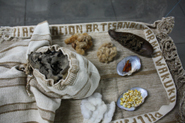Peruvian mummy focuses attention on death, memory in the Amazon

Photo from the National University of San Martin Regional Museum
LAWRENCE – Although more than a decade has passed since Peru's 20-year violent civil war with guerrilla forces ended in 2000, many indigenous Peruvians are reluctant to speak publicly about death and memory – the essence of the truth and reconciliation efforts now in progress.
Last fall Bartholomew Dean, a University of Kansas social anthropologist specializing in Peru's Upper Amazon, initiated a cultural revalorization project at the Regional Museum of the National University of San Martín in Tarapoto "to provide a window to talk about death and talk about memory."
Cultural revalorization refers to renewing emphasis of indigenous cultural traditions, world views and ways of life that have been taken for granted, marginalized or even oppressed.
Dean is one of a handful of specialists on the societies of the Upper Amazon. His research is oriented toward cultural survival and community well-being. Currently he focuses on understanding the consequences of migration and urbanization in the Amazon, particularly the social trauma associated with the civil war.
"We are dealing with the death of ethnos, of cultures, with dying societies," Dean said of the impact of political violence, industrialization and urbanization on the Upper Amazon.
More than 70,000 Peruvians disappeared or were killed in the civil war. Indigenous populations suffered high losses. Disease and industrial exploitation have also savaged indigenous villages. Urbanization is pushing many indigenous people from the comfort of their ancestral land to subsistence in cities.
He compares the struggle for cultural survival among Peru's indigenous people today to that of native peoples in United States during the 19th and 20th centuries.
As a 2011-12 Fulbright teaching and research scholar at the National University of San Martín (UNSM), Dean suggested a ceremonial rewrapping of a 450-year-old mummy in the university's Regional Museum. He was seeking "a somewhat safe way to help a part of the world that has been traumatized with deep, deep wounds begin to talk about death and memory."
News of the ceremonial rewrapping focused attention on the museum's efforts to acknowledge Peruvian Amazon peoples' contributions to the world and on the past. The mummy was a woman believed to have been a weaver because of tools, including spindle whorls, found at her burial site in the Shimbillo-Chazuta area, southeast of Tarapoto. A local Kechwa women's weaver association skilled in using traditional fibers, dyes and designs was invited to create a new garment for the mummy.
"Although the mummy was not central to our research, the ritual rewrapping generated interest in recognizing the importance of the distant past," Dean said.
"We're hopeful that by understanding the distant past, people will be more willing to discuss the recent past."
Dean returns to Peru in June to direct KU's Ethnographic Field School, where student anthropologists learn skills to work in the Amazon's jungles. He will also supervise a KU graduate student recipient of a U.S. Embassy internship at the UNSM Regional Museum. Braden Conrad-Hiebner, of Nebraska, is working on master's degrees in anthropology and museum studies.
Peru's Minister of Culture has invited Dean and his KU students to present their research at the National Museum in Lima on June 27.
Dean's commitment to graduate study in the Amazon has included working with two universities in Peru to help establish graduate programs. Last fall he and three KU graduate students collaborated with the faculty at San Martin to establish a new interdisciplinary graduate program for the systematic study of social change and community welfare in the Upper Amazon. In 1999, he helped found a graduate program in Amazonian studies at the National University of San Marcos in Lima.
Dean has worked intermittently in the Peruvian Amazon since the 1980s when he was a doctoral student at Harvard University. After joining KU's faculty in 1995, Dean began working with the National University of San Marcos in Lima, and more recently has worked with the National University of San Martin's Regional Museum. His books include "Urarina Society, Cosmology and History in Peruvian Amazonia" and "At the Risk of Being Heard: Identity, Indigenous Rights, and Postcolonial States."
The Peruvian Amazon is not only one of the most biologically diverse places on Earth, providing a wealth of pharmaceutical medicines, it also a source of information about patterns of human migration and the transmission of diseases and pathogens. KU's Laboratory of Biological Anthropology is analyzing genetic and osteologic data from the Regional Museum mummy for clues about migration.
"Anthropology is the link between cultural and biological diversity," Dean said.
The Regional Museum is "a platform to begin to highlight the incredible contribution Amazonian people have given to everyone on the planet."